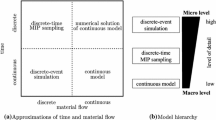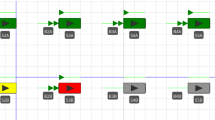Abstract
We study the effect of changing buffer sizes in serial lines withgeneral blocking, a mechanism that incorporates limited intermediate finished goods inventory at each stage, as well as limited intermediate raw material inventory. This model includes ordinarymanufacturing, communication, andkanban blocking as special cases. We present conditions under which increasing buffer sizes or re-allocating buffer capacity increases throughput, and in some cases characterize optimal allocations. Our comparisons hold pathwise; they depend on structural properties of a line but not its service time distributions.
The key to our analysis is formulating the model as a generalized semi-Markov process (GSMP). We show that a serial line with general blocking possesses various structural properties from which pathwise comparisons follow directly, making a detailed case-by-case analysis unnecessary. These results help illustrate the power of GSMPs as a modeling framework.
Similar content being viewed by others
References
Ammar, M. A., and Gershwin, S. B. 1989. Equivalence relations in queueing models of fork/join networks with blocking.Performance Evaluation 10: 233–245.
Anantharam, V., and Tsoucas, P. 1990. Stochastic concavity of throughput in series of queues with finite buffers.Advances in Applied Probability 22: 761–763.
Baccelli, F., Makowski, A., and Shwartz, A. 1989. The fork-join queue and related systems with synchronization constraints: stochastic ordering and computable bounds.Advances in Applied Probability 21: 629–660.
Buzacott, J. A. 1967. Automatic transfer lines with buffer stocks.Int. J. Prod. Res. 5: 183–200.
Buzacott, J. A. 1988. Kanban and MRP controlled production systems. Submitted for publication.
Buzacott, J. A., and Shanthikumar, J. G. 1992.Stochastic Models of Manufacturing Systems. Englewood Cliffs, NJ: Prentice-Hall.
Cheng, D. W. 1990.Tandem Queues with General Blocking: Stochastic Comparisons and Structural Properties, Ph.D. thesis, Columbia University.
Cheng, D. W. 1991a. Second-order properties of system throughput and system size of a tandem queue with general blocking. Submitted for publication.
Cheng, D. W. 1991b. Line reversibility of tandem queues with general blocking. Department of Statistics and Operations Research, New York University, New York, NY 10003.
Cheng, D. W., and Yao, D. D. 1993. Tandem queues with general blocking: a unified model and stochastic comparisons.Discrete Event Dynamic Systems: Theory and Applications 2: 207–234.
Conway, R., W. Maxwell, J. O. McClain, and L. J. Thomas. 1988. The role of work-in-process inventory in serial production lines.Operations Research 36: 229–241.
Dallery, Y. and D. Towsley. 1991. Symmetry property of the throughput in closed tandem queueing networks with finite buffers.Operations Research Letters 10: 541–547.
Gershwin, S. B. 1987. An efficient decomposition method for the approximate evaluation of tandem queues with finite storage space and blocking.Operations Research 35: 291–305.
Glasserman, P. 1991. Structural conditions for perturbation analysis derivative estimation: finite-time performance indices.Operations Research 39: 724–738.
Glasserman, P., and D. D. Yao. 1992a. Monotonicity in generalized semi-Markov processes.Mathematics of Operations Research 17: 1–21.
Glasserman, P., and D. D. Yao. 1992b. Generalized semi-Markov processes: antimatroid structure and secondorder properties.Mathematics of Operations Research 17: 444–469.
Glynn, P. W. 1989. A GSMP formalism for discrete-event systems.Proceedings of the IEEE 77: 14–23.
Ho, Y. C., Eyler, M. A., and Chien, T. T. 1979. A gradient technique for general buffer storage design in a production line.Int. J. Prod. Res. 17: 557–580.
Lim, J.-T., Meerchov, S. M., and Top, F. 1990. Homogeneous, asymptotically reliable serial production lines: theory and a case study.IEEE Trans. Automatic Control T-AC 35: 524–534.
Meester, L. E., and Shanthikumar, J. G. 1990. Concavity of the throughput of tandem queueing systems with finite buffer storage space.Advances in Applied Probability 22: 764–767.
Mitra, D., and Mitrani, I. 1990. Analysis of a novel discipline for cell coordination in production lines, I.Management Science 36: 1548–1566.
Muth, E. J. 1979. The reversibility property of production lines.Management Science 25: 152–158.
Rajan, R. and Agrawal, R. 1992. Structural properties of the throughput in cyclic networks with general blocking and starvation. Submitted toQUESTA.
Schassberger, R. 1978. Insensitivity of steady-state distributions of generalized semi-Markov processes. Part I.The Annals of Probability 5: 87–99.
Shanthikumar, J. G., and Yao, D. D. 1989. Monotonicity and concavity properties in cyclic queueing networks with finite buffers, inQueueing Networks with Blocking, H. Perros and T. Altiok (Eds.), Elsevier Science, 325–344.
Sparaggis, P. D., and Gong, W. B. 1990. A GSMP model for the buffer allocation problem in cyclic networks.Proceedings of the 29th IEEE Conference on Decision and Control, Honolulu, Hawaii, 903–908.
Tayur, S. R. 1990. Structural properties of a Kanban controlled serial manufacturing system. Technical Report #934, School of OR/IE, Cornell University, Ithaca, NY 14853.
Tayur, S. R. 1991. Kanbans, generalized semi-Markov processes and anti-matroids, Technical Report #954, School of OR/IE, Cornell University, Ithaca, NY 14853.
Tsoucas, P., and Walrand, J. 1989. Monotonicity of throughput in non-Markovian networks.Journal of Applied Probability 26: 134–141.
Whitt, W. 1980. Continuity of generalized semi-Markov processes.Mathematics of Operations Research 5: 494–501.
Yamazaki, G., and Sakasegawa, H. 1975. Properties of duality in tandem queueing systems.Ann. Inst. Stat. Math. 27: 201–212.
Zipkin, P. 1989. A Kanban-like production controlled system: analysis of simple models. Working Paper, Columbia University Graduate School of Business.
Author information
Authors and Affiliations
Rights and permissions
About this article
Cite this article
Glasserman, P., Yao, D.D. Structured buffer-allocation problems. Discrete Event Dyn Syst 6, 9–41 (1996). https://doi.org/10.1007/BF01796782
Issue Date:
DOI: https://doi.org/10.1007/BF01796782




